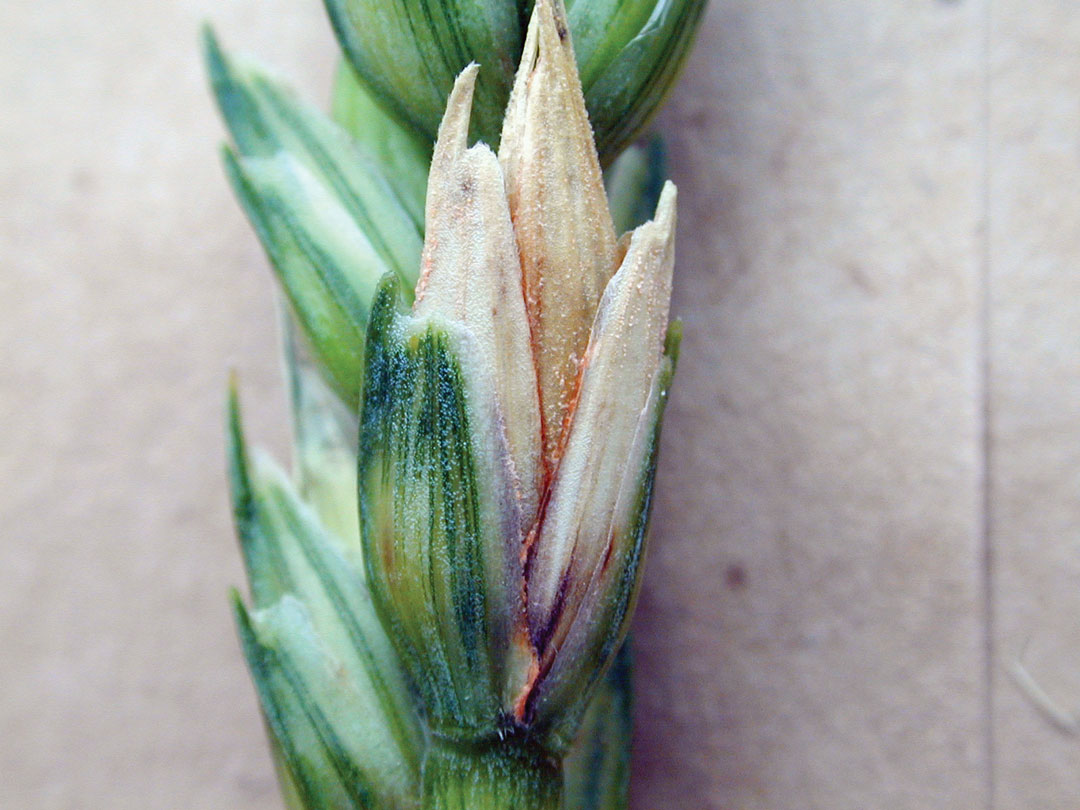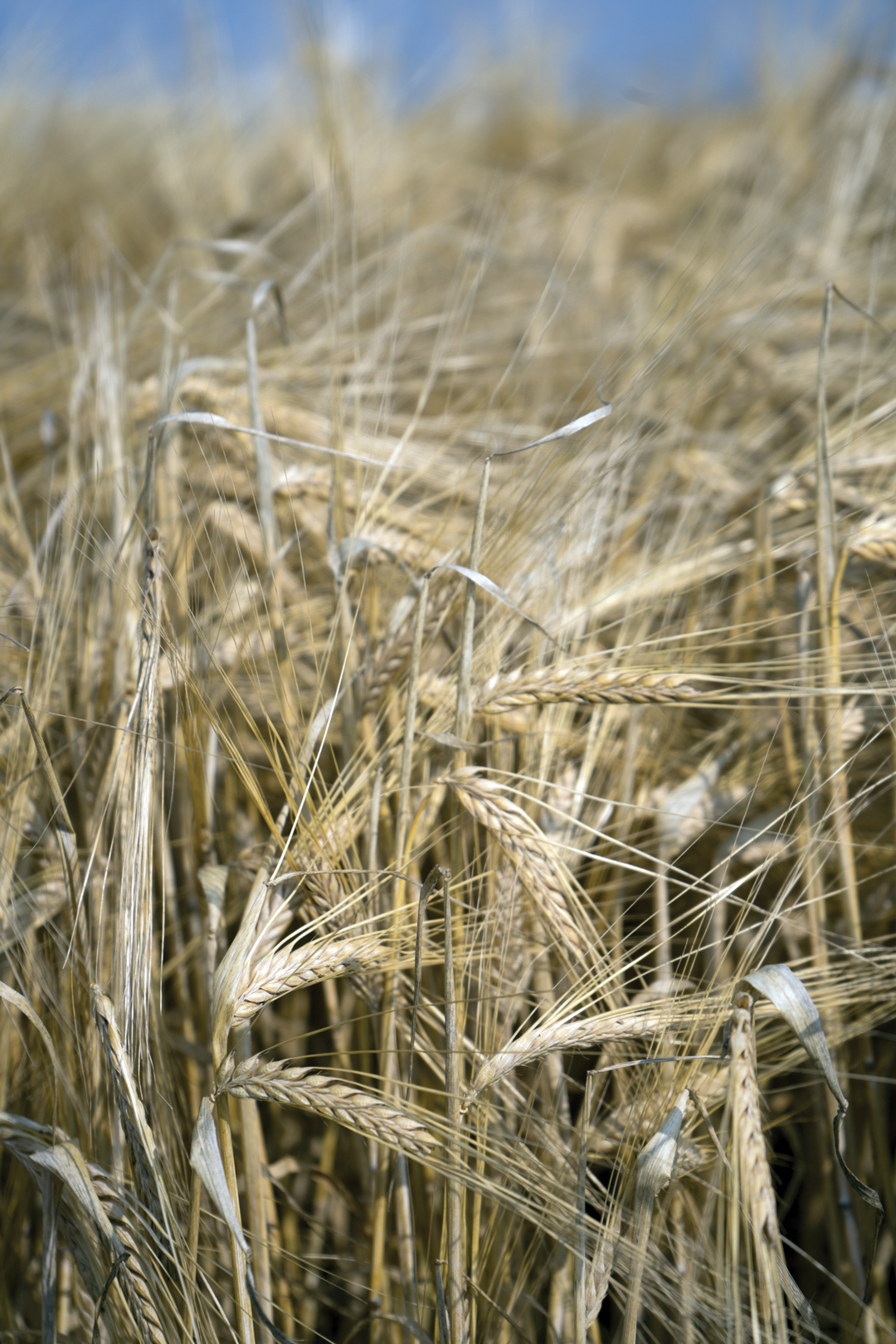FIGHT THE BLIGHT
FHB REGULATIONS, COMPLICATIONS AND MANAGEMENT
BY MELANIE EPP
In 2016, farmers faced possibly the worst Fusarium head blight (FHB) damage year in Canadian history. Already established in Manitoba and Saskatchewan, the disease is now spreading across Alberta, where tight regulations leave some farmers scrambling to source clean seed. Prevention and rotation are crucial in avoiding losses, and new tools are available to help farmers fight the disease.
Each year, the Canadian Grain Commission (CGC) posts its annual harvest survey results for FHB. According to CGC research scientist Tom Gräfenhan, 2016 was a benchmark year for Fusarium damage. “We had over 70 per cent of durum samples affected by the disease,” he said. “A significant amount of that 70 per cent ended up in the feed or lower grade. A lot of durum was not marketable.”
While the numbers for 2017 haven’t been posted yet, Gräfenhan said damage wasn’t nearly as bad as in the previous year. In durum, Fusarium was present in only two per cent of western Canadian samples. By comparison, it was present in just six per cent of 2017 red spring wheat samples; in 2016, over 50 per cent of red spring wheat crops were affected. “Red I spring gives you the best picture, while durum gives you the worst picture,” said Gräfenhan.
Fusarium regulations vary from province to province. In Manitoba, where there are no restrictions or thresholds for planting infected seed, it’s advised that seed grain be tested for germination and infection. Saskatchewan doesn’t regulate the disease as a pest, but the province recommends growers not use seed containing more than five per cent Fusarium graminearum to minimize its spread.
In Alberta, however, the disease is a declared pest under the Agricultural Pests Act, meaning grain containing detectable levels of F. graminearum cannot be used for seed.
The regulation put Alberta in a tight spot in 2016 when Fusarium levels were high. “This is where it becomes contentious,” said Michael Harding, a plant pathology research scientist with Alberta Agriculture and Forestry. “It really negatively affects seed producers that end up with Fusarium on their grain because, according to the Agricultural Pests Act, it’s against the law to sell it for propagation purposes.
“Alberta growers could sell infected grain for milling as seed into another province as long as it’s transported according to the guidelines listed in the Act,” he continued. “There are other options, they just can’t sell it as seed.”
As it becomes more common on the Prairies, Fusarium has created problems for farmers, including yield loss, downgrading issues and market acceptability issues when mycotoxin concentrations are high—and Alberta seed producers are particularly hard hit. In Alberta, FHB has most commonly been found—and done the greatest damage—in the southern part of the province, said Harding. “But in 2010, the information we were getting from the seed testing labs and from the Canadian Grain Commission was indicating that it was becoming more common than it previously had been in areas outside southern Alberta,” he said.
In 2015 and 2016, Alberta Agriculture and Forestry (AF) conducted a survey that determined FHB levels were quite high in a number of counties outside southern Alberta. Those areas, including along the Saskatchewan border as far north as Lloydminster, now have significant levels. “It looks as though Fusarium either is becoming, or has become, well established along the eastern border,” said Harding.
Given that FHB doesn’t simply go away once established, some farmers believe a near-zero-tolerance policy no longer makes sense. “If you’re in an area where it’s really common, it really doesn’t make any difference if there’s a little bit of Fusarium on the seed because it’s already established in the crop residue at a level much higher than it would be on the seed,” said Harding. But, he added, “We want to prevent it from spreading.”
For Greg Stamp, whose 5,500-acre seed growing operation is located near Enchant in southern Alberta, FHB can be an issue. He says 2016 was a particularly tough year, especially for durum, and that it’s difficult to get certain varieties into the province because of low-level FHB. “Some varieties aren’t accessible in Alberta, period, the way the rules are set up,” he said. “So, that puts Alberta behind a little bit.
“Some of the companies that want to grow high-generation seed here, maybe they’re scared to because if it has half a per cent Fusarium, then they can’t use it even though that number is quite manageable,” he said.
On the plus side, a bad FHB year can also generate interest in other provinces for Alberta-grown seed. “In 2016, we had farmers looking for durum,” said Stamp. “Some farmers in Saskatchewan were just happy to get something that had lower disease levels and better germination.”
MANAGING FUSARIUM
To avoid yield loss, prevention is key, said Kelly Turkington, Agriculture and Agri-Food Canada research scientist. Growers who are concerned about Fusarium in 2018 should look at how their crop did in 2017, said Turkington. Was it downgraded? Did tested seed come back positive? “That will give them some indication of what could potentially happen,” he said.
For those who live in regions where typical rotations are canola-wheatcanola-wheat, this year may present an issue. Those who were in wheat in 2016 when FHB hit a record-high level might consider skipping wheat this year. “That residue from 2016 would still be in the field and could contribute spores that could infect their 2018 crop,” said Turkington, who also advises farmers to determine if their neighbours have FHB problems. “If you’re looking to plant a cereal crop, and adjacent fields have been in corn for a while, there’s an elevated risk,” he said.
He also emphasized fungicide timing as an important factor that determines impact. “If you’re looking at using a fungicide, the problem is that you have to make the decision to spray before you actually see disease symptoms in the crop,” said Turkington. “If your weather maps are indicating that you’re at moderate to high risk, and your previous history with the issue has it well established in your fields or neighbouring fields, in that situation, spraying might improve grade and could mean a sizable economic benefit.”
Agriculture and Agri-Food Canada research scientist Brian Beres advocates management of the disease by optimizing genetics and using techniques that overcome the environment in which the crop is growing. He says crop uniformity is critically important. In wheat, this can be achieved by bumping seeding rates. “The big problem with Fusarium is that the growth phase in flowering is where the plant is most susceptible, so if you’ve got a bunch of main stems at one stage and a bunch of tillers coming on later, that plant is potentially at risk for a month,” he said.
Proper rotation is also crucial to minimizing damage, but Beres believes producers are faced with a dilemma when selecting crop sequencing. “It’s a business,” he said. “And everything at the end of the day has to be profitable. But we wouldn’t want to see something susceptible to Fusarium appearing more than once every four years.”
Farmers sometimes plant host crops without knowing they’ve done so. Beres cited a farmer who appeared to have a great rotation plan, but didn’t. His rotation included yellow mustard, durum, chem fallow and field peas. What appeared to be a diverse, non-host crop rotation was not. “If you look a little closer, the only non-host is the mustard, theoretically,” he said.
Fusarium could colonize on the dead tissue left during the chem fallow phase, explained Beres, and, as this farmer discovered, field peas can also be a host. “It’s not common,” he said. “But it can happen.
“Rotation is extremely difficult to overcome and underscores the fact that, as much as possible, we need to have non-host phases, but it’s hard at the farm level to achieve that because, in periods of really high FHB infestations, it’s tough to find a non-host unless you want to get really creative,” he said.
“It really is about making sure you have the best genetics and the best management strategies,” he said. “If you don’t adapt the genetics or the management to the current environment, you’re going to get killed.”
Probably the biggest contributing factor to Fusarium, though, is the environment. The governments of Manitoba and Saskatchewan both post daily risk maps to let growers know when conditions are right for the disease to take hold. In collaboration with the Alberta Wheat Commission, the Alberta Climate Information Service has created the Fusarium Head Blight Risk Tool, available online at weatherdata.ca as a mobilefriendly website.
By clicking on the map button, growers can view risk assessments across the province and select the weather station closest to their farm for regionally specific details. The tool takes into consideration precipitation and temperature for the past seven days, indicating what’s to come. “We provide the environmental risk for the infection, but the farmer needs to understand whether his crop is in a susceptible stage and if he has disease in the area,” said Ralph Wright, manager of AF’s Agro-Meteorological Applications and Modelling unit. “It’s not a decision-making tool. It’s a decision-support tool.”








Comments